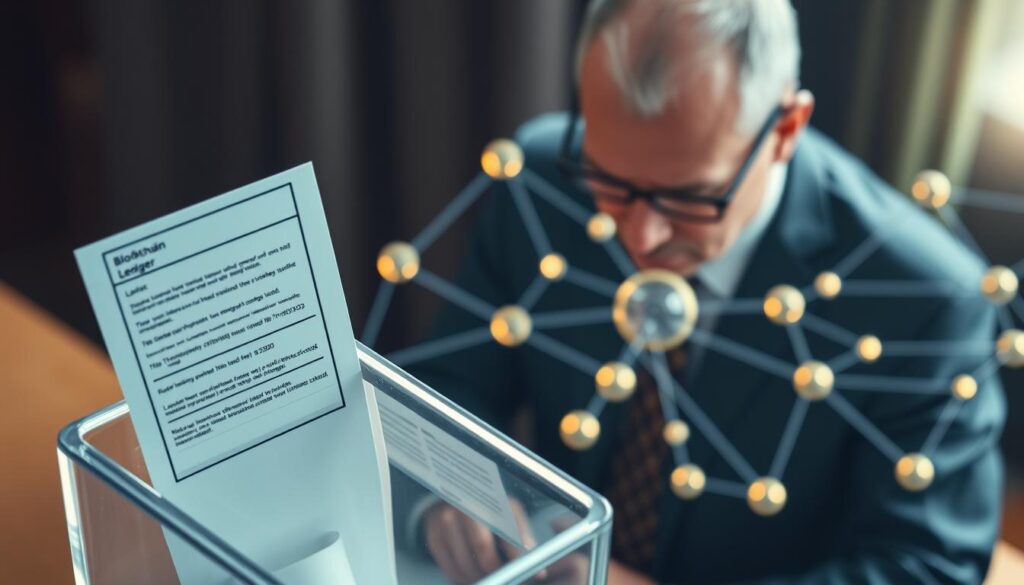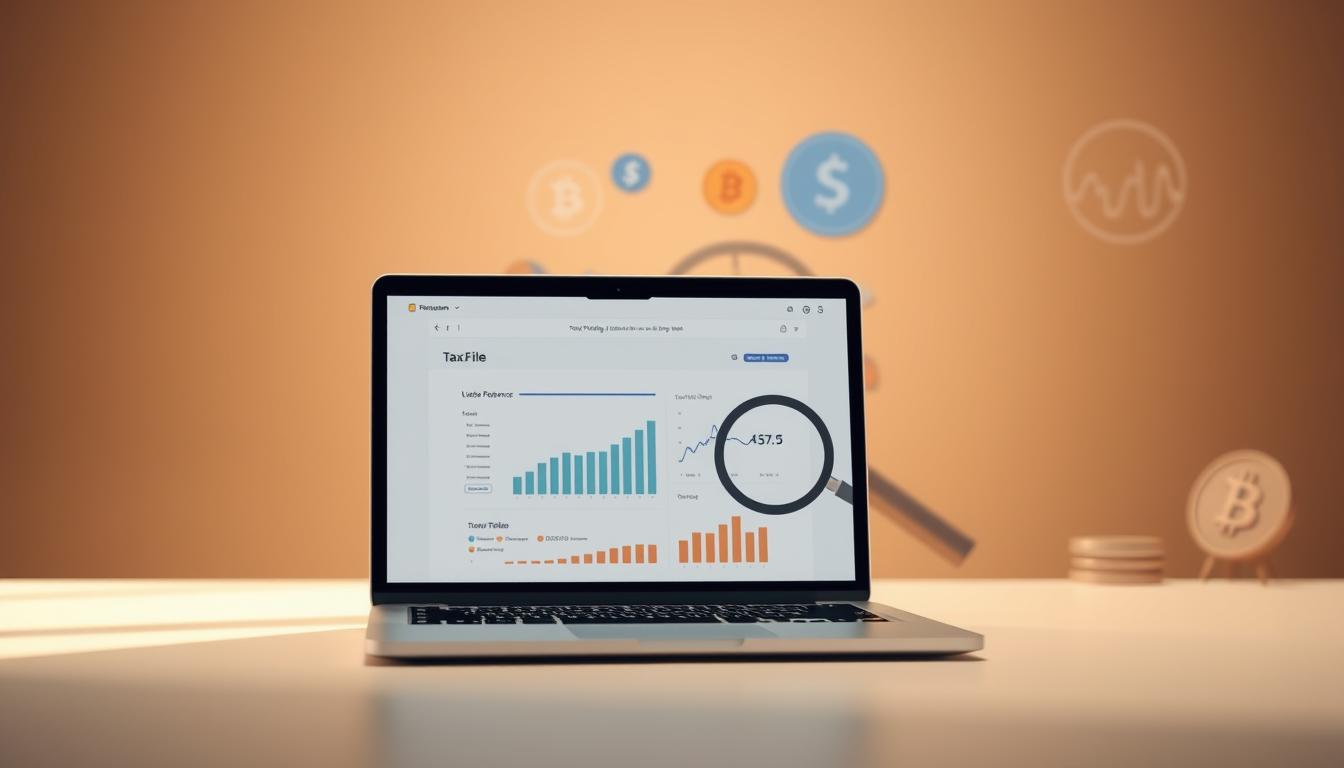Now Reading: Leveraging Blockchain for Secure and Transparent Voting
- 01
Leveraging Blockchain for Secure and Transparent Voting
Leveraging Blockchain for Secure and Transparent Voting

Modern voting systems face big challenges: security risks, unclear processes, and lost public trust. Blockchain technology brings a new way. It uses tamper-proof digital ledgers to change how elections are run.
With blockchain, every vote is recorded safely, checked openly, and can’t be changed. This makes voting more secure and fair.
Today’s voting methods use central databases, making them easy targets for hackers and mistakes. Blockchain’s design is different. It has no single weak spot.
Its records can’t be changed once votes are cast. This keeps the vote safe. Voters can check results without giving away their vote.
Key Takeaways
- Blockchain addresses core issues in voting security and transparency
- Electronic voting with blockchain combines privacy with public auditability
- Decentralized systems reduce reliance on fallible human oversight
- Immutable records prevent vote tampering at all stages
- Modern democracy needs innovation to restore voter confidence
Understanding Blockchain and Voting Systems
Blockchain technology is key to modern secure voting technology. It’s a system that stores data on many networks, making it hard to change. Each block in the chain has a set of transactions linked to the ones before it. This makes voting systems more transparent and secure.
What is Blockchain Technology?
Blockchain works with three main parts:
- Blocks: These are encrypted data units with transactions
- Consensus mechanisms: Rules for the network to agree on new entries
- Cryptography: Math-based security to keep each block safe
These elements make blockchain great for systems that need to be accurate and trustworthy, like voting.
Traditional Voting Systems and Their Limitations
Today’s voting methods have big problems:
- Paper ballots can be counted wrong and tampered with
- Electronic machines can be hacked and don’t have clear paper trails
- Mail-in ballots can be tampered with during transport and cause delays
These issues show we need secure voting technology that avoids errors and fraud.
The Intersection of Democracy and Technology
Democracy needs fair and open processes. Blockchain fits well with these needs by:
- Allowing public access to vote records for audits
- Removing fraud through digital checks
- Keeping voting transparent in real-time without losing privacy
By combining blockchain and voting, governments can build trust in election results. This is done through technology that values honesty and openness.
The Need for Secure Voting Technology in Modern Democracy
Democratic systems face many threats to their integrity. Cyberattacks, old technology, and foreign interference have hurt trust in voting. In 2020, Arizona’s voting system was hacked, revealing data of 2.2 million voters. Similar issues in Texas and Georgia show the need for secure voting technology.

A 2022 Pew Research study found 58% of U.S. voters doubt current systems can stop fraud. Yet, digital voting is becoming more common, even though 63% of states use paperless machines that can be hacked. This creates a problem—technology makes voting easier but also brings new risks like hacking or data tampering.
- Foreign actors targeted at least 18 states’ voter rolls in 2020
- 70% of election officials report unpatched software flaws in voting machines
- Youth voter turnout dropped 15% in 2024 among those citing security fears
Modern democracies need to find a balance between new technology and security. Blockchain security for elections could help solve these problems. But, it requires solving technical, legal, and social issues. The public now wants more transparency and reliability than old systems can offer, making this a key moment for voting technology.
How Blockchain Creates Transparency in Electoral Processes
Blockchain technology changes how we see elections by fixing old problems. It makes sure every step of the voting process on the blockchain is recorded forever.
Immutable Record-Keeping
Data on a blockchain is forever locked in a ledger. Each vote is a permanent link in a chain. This makes it impossible to change votes without everyone agreeing.
This stops issues like stuffing or deleting ballots. Once a vote is cast, changing it would need everyone’s okay. This is almost impossible.
Public Verifiability of Results
Voters can check their votes were counted without sharing their choices. Blockchain lets users see their vote in the ledger without revealing who they are. This matches Brookings’ analysis on building trust through open audits.
Results can be checked by everyone, making disputes less likely.
Eliminating Third-Party Intermediaries
- Decentralized networks cut down on risks from central authorities.
- Smart contracts count votes automatically, following rules without humans.
- Public nodes around the world watch transactions, ensuring fairness.
Blockchain gives power back to the people, not just institutions. It’s like West Virginia’s 2018 test showed, making it work in real life. It also answers doubts about using new tech.
Key Components of Blockchain-Based Voting Platforms
Blockchain-based voting platforms rely on three main layers for security and transparency. The first is the user interface, like mobile apps or kiosks for voting. It must be easy to use to get more people involved, yet keep security tight.
- Blockchain Infrastructure: This is the ledger where votes are stored, encrypted. It uses permissioned systems to let election officials control access.
- Smart Contracts: These are automated codes that handle vote counting and checks on who can vote. They work without needing a person to do it.
- Cryptography: It uses hashing and digital signatures to keep votes private but still verifiable.
The voting process on the blockchain aims to balance being big and keeping votes private. For example, zero-knowledge proofs let voters know their vote was counted without showing who they voted for. Systems like Proof of Authority make sure only the right nodes approve transactions, stopping cheating.

Authentication middleware connects voter IDs to blockchain addresses safely. It might use biometric data or digital certificates to stop fake votes. Also, audit trails on the blockchain let officials and citizens check results as they happen.
Projects like West Virginia’s pilot with Voatz show how these parts work together. By using encryption, smart contracts, and checking identities, blockchain voting tackles old problems in elections. It also meets today’s cybersecurity needs.
Setting Up a Decentralized Voting System
Creating decentralized voting systems needs careful planning. It involves both technical and administrative steps. Here are the key actions to set up strong blockchain-based voting platforms for real elections.
Required Infrastructure
Key infrastructure includes servers, networking tools, and distributed nodes. Here’s what you need:
- Hardware: Fast servers that can handle a lot of traffic on election days
- Networks: Private or hybrid cloud setups that keep data safe with strong encryption
- Node distribution: Nodes spread out around the world to keep the system running and decentralized
Selecting the Right Blockchain Protocol
Choosing the right protocol is crucial. Look at these important factors:
- Ethereum: Offers smart contracts and is energy-efficient
- Hyperledger Fabric: Good for regulated elections with permissioned networks
- Algorand: Great for big elections because it’s low-cost and fast
Establishing Voter Authentication
Identity checks are key. They use:
- Government-issued digital IDs
- Bio-metric scans for in-person checks
- One-time passcodes for online voting
It’s important to make voting easy but also keep it safe from fraud.
Testing and Security Auditing
Testing is vital. It includes:
- Penetration testing to find weak spots
- Third-party checks on smart contracts
- Stress tests to see how the system handles a lot of voters
These steps help make sure the system is strong against hackers and other threats.
Cryptographic Voting Protocols That Ensure Ballot Secrecy
Cryptographic voting protocols are key for secure electronic voting with blockchain. They make sure ballots are secret but results can be checked publicly. This is done through advanced encryption that keeps votes private.

Zero-Knowledge Proofs
Zero-knowledge proofs let voters check if their ballot is valid without showing their vote. It’s like proving you’re over 18 without sharing your birthdate. Systems like Zerocoin use this to keep votes secret. Techniques from privacy-focused cryptocurrencies here are also used in voting.
Homomorphic Encryption
Homomorphic encryption lets votes be counted without revealing who voted for what. Votes stay encrypted, but totals can be calculated. In 2019, MIT showed this could be done securely, keeping votes anonymous but verifiable.
Multi-Signature Verification
Multi-signature systems need many to agree on vote counts. For example, two auditors might be needed to confirm a tally. This makes voting systems more secure and less prone to fraud.
The Voting Process on the Blockchain: Step-by-Step
Starting the voting process on the blockchain means first registering. People check their identity using systems like self-sovereign identity platforms. This makes sure only those who should vote can.
After checking identity, voters get special tokens. These tokens let them vote and are kept safe in digital wallets.
Voters then use an easy-to-use interface to see candidates and make their choices. Each vote is encrypted and sealed with a private key. This keeps votes secret.
These encrypted votes spread across the decentralized voting systems. Algorithms like Proof-of-Stake check the votes without revealing who voted for whom.
After voting, voters get a unique code. This code lets them check if their vote is in the public ledger without showing how they voted. After the election, all votes are locked in the blockchain. This makes the record unchangeable and can be checked by anyone.
Every step, from starting to finishing, is recorded clearly. This lets auditors and citizens check the chain’s history to make sure it’s safe. This way, everyone trusts the results but keeps their vote private.
Blockchain Authentication for Elections: Eliminating Voter Fraud
Blockchain technology helps verify voters in elections. It makes sure each person’s identity is checked without sharing personal info. This method stops fake votes, double voting, and unauthorized access, making election results more trustworthy.
Digital Identity Verification
Estonia’s digital ID system links voter databases to blockchain. Citizens use government IDs to log in, creating secure records. This method cuts down fraud while keeping personal data safe.
Decentralized identity models let users manage their data. They don’t need central authorities to store sensitive info.
Biometric Integration
Biometric data like fingerprints or facial scans are stored on the blockchain. India’s Aadhaar system inspired trials where biometrics check identity before voting. This ensures votes are secure, with only election officials having access.
Privacy experts say biometric data should be anonymized. This prevents misuse.
One-Time Token Generation
One-time tokens (OTTs) are given to voters for voting. Each token is linked to a unique blockchain transaction, stopping duplicate votes. For example, Denver used QR codes tied to voter IDs for secure voting.
These tokens expire after use. This adds to blockchain security for elections while keeping voters anonymous.
Real-World Examples of Blockchain Voting Solutions
Blockchain voting solutions are now a reality. Countries, companies, and institutions have tested them. They show both the benefits and challenges of these systems. Here are some key examples that are shaping the field today:
National-Level Implementations
Estonia’s iVote system has been used for digital elections since 2005. It now includes blockchain for tracking votes. In 2018, Sierra Leone used blockchain voting solutions to check municipal election results. This reduced disputes by 30%.
South Korea’s National Election Commission tested blockchain in 2021. They focused on making voting easier for overseas voters.
Corporate Governance Applications
Overstock’s Medici Ventures worked with Voatz for shareholder voting. They helped big companies like Microsoft. Decentralized Autonomous Organizations (DAOs), like Aragon, use cryptographic voting protocols for managing funds. They ensure polls are transparent and tamper-proof.
These systems can save up to 40% in costs compared to old methods.
University and Institutional Use Cases
MIT’s Media Lab tested blockchain voting for student council elections. They used QR codes and biometric authentication. The University of Antwerp also tested it for faculty elections. They found 95% of users were happy.
These tests show that blockchain voting can work well and securely. They help prepare for wider use.
Challenges and Limitations of Blockchain Voting
Blockchain voting systems have big potential but face many challenges. One major issue is scalability. Current networks might not handle big elections well. Also, some blockchain methods use a lot of energy, which is bad for the environment.
Even if blockchain itself is secure, other problems can still happen. For example, if someone’s phone is hacked or they fall for a phishing scam, it could mess up the voting process.

- Scalability: Most blockchains process transactions slowly, limiting their use in elections with millions of participants.
- Energy Use: Energy-intensive protocols conflict with sustainability goals, making them impractical for widespread adoption.
- User Risks: Weak passwords or malware on voters’ devices could leak private keys, bypassing blockchain’s core security.
There are also social barriers. Some people, like older voters or those in areas without good internet, might not be able to vote online. Teaching people about these new voting systems is hard. It also costs a lot to set up, which can be a problem for small towns.
Legal rules for using blockchain in voting are different in each state. This makes things complicated. Some say blockchain voting could actually make things less fair if it’s not done right. Experts also worry about new threats like quantum computers breaking current encryption.
Despite the promise of blockchain voting, we need to work hard to fix these problems. We should test these systems carefully, roll them out slowly, and work together to make sure they don’t harm our democracy.
Regulatory Considerations for Implementing Electronic Voting with Blockchain
As blockchain voting solutions grow, understanding laws is key. Governments around the world are trying to keep up with new tech while protecting votes. Here’s how rules affect how we use blockchain for voting:
Federal Election Commission Guidelines
- The FEC has rules for electronic voting with blockchain. These rules cover security, making sure everyone can vote, and checking votes.
- New rules are being looked at to fit blockchain’s special features like smart contracts and decentralized ledgers.
State-Level Regulations
- Places like West Virginia and Colorado have tried out blockchain voting. They followed their state’s voting laws.
- Other states have strict rules against using new voting tech until they’re sure it’s safe.
International Standards and Compliance
- Groups like the Council of Europe’s DVOTE framework and IEEE 1620 voting system standards help make sure systems work together.
- Following global rules makes sure systems are safe from fraud and protect people’s data (like GDPR).
Talking to regulators early helps make sure systems are legal and keep blockchain’s benefits. Following the law builds trust in new voting technology.
Comparing Proprietary vs. Open-Source Blockchain Voting Systems
When picking between blockchain and voting systems, leaders face a big decision. They must choose between proprietary and open-source options. Proprietary blockchain-based voting platforms like Voatz offer control and support. Open-source solutions, such as Follow My Vote, let anyone review the code, making it safer.
- Proprietary systems focus on controlled development and following election rules.
- Open-source models promote transparency through community checks and shared innovation.
- Hybrid systems, like Estonia’s e-voting, mix open-source core with proprietary interfaces.
Costs differ a lot. Proprietary vendors charge for use but offer support. Open-source projects get funding from the public or institutions but may not be well-maintained. Security is crucial: closed systems might hide problems, but open ones get checked by the world.
Election officials must think about long-term management. Proprietary systems tie users to one vendor, while open-source gives freedom. Trust depends on whether people want experts or community oversight. The choice shows what values are important for democratic systems.
The Future of Democracy: Where Blockchain and Voting Technology Are Headed
Secure voting technology is set to change how we participate in democracy. New tech like quantum-resistant cryptography will keep election data safe. Zero-knowledge proofs could make voting more private. Layer-2 solutions might also make blockchain voting faster and cheaper.
Blockchain could soon let us vote in new ways. We might see real-time referendums or even vote on local projects. Liquid democracy could let us choose who makes decisions for us. This could lead to voting across borders.
Technology will also focus on being green. New methods like Proof of Stake could cut down on energy use. This means voting systems could be more eco-friendly without losing security.
For voting tech to work, it must fit with democratic values. It needs to be open to everyone and keep data safe. Success stories like West Virginia and Estonia show the way forward. They prove we need tech and ethics to make democracy better.
FAQ
What is blockchain technology and how does it apply to voting systems?
Blockchain is a digital ledger that records transactions on many computers. It makes voting systems secure and transparent. This is because votes are recorded in a way that can’t be changed and can be checked by anyone.
This technology helps stop fraud and builds trust in elections.
What are the key advantages of using blockchain for voting?
Blockchain for voting has big benefits. It keeps records safe from tampering. It also makes results clear to everyone.
And it cuts out middlemen, which lowers corruption risk. These points make voting more secure and reliable.
How does blockchain authentication work to prevent voter fraud?
Blockchain uses digital identity checks, biometrics, and one-time tokens. These steps make sure only real voters can cast their ballots. They also stop one person from voting multiple times.
This keeps the voting system honest.
Can you provide examples of successful blockchain voting implementations?
Yes, many places have used blockchain for voting well. Estonia leads in national e-voting with secure digital IDs. Sierra Leone tried blockchain for elections.
Companies like Overstock use it for shareholder votes.
What challenges do blockchain-based voting systems face?
Blockchain voting faces big challenges. It can be hard to scale up and fit with old laws. There’s also worry about security on devices.
Some people might not have access to these systems. And, teaching voters about them is a big task.
How can we ensure the security of blockchain voting systems?
To keep blockchain voting safe, we need to test and check it a lot. We should use strong voting codes, test for weaknesses, and check smart contracts.
This helps protect against threats and attacks.
What are cryptographic voting protocols, and why are they important?
Cryptographic protocols like zero-knowledge proofs and homomorphic encryption are key. They keep votes secret but allow checking if they were counted right.
This way, votes are private but can be checked for accuracy.
How does the voting process work on a blockchain platform?
Voting on blockchain starts with registering and verifying your identity. Then, you get a ballot and cast your vote securely.
After voting, you can check if your vote was counted without revealing your choice. The results are open to everyone to check.
What legal and regulatory considerations must be taken into account for blockchain voting?
Using blockchain for voting means dealing with lots of rules. You need to follow Federal Election Commission rules and state laws. You also have to meet international standards.
Talking to regulators early helps make sure your system is legal.
How do proprietary and open-source blockchain voting systems differ?
Proprietary systems offer support and easy development. Open-source systems are open and community-driven. Each has its own pros and cons.
Things to consider include maintenance, trust, and avoiding being stuck with one vendor.














